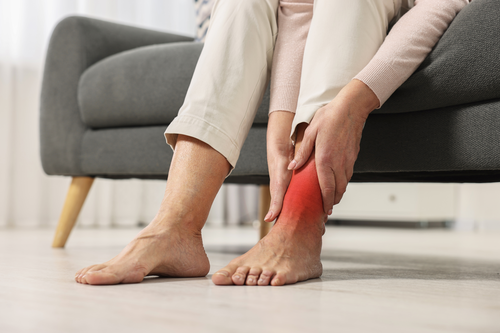A sprained ankle is an injury that can happen to anyone whether you’re playing sports, walking on uneven ground or just stepping wrong. Knowing how to treat a sprained ankle properly, especially in cases of an acute ankle sprain, is key to a full and quick recovery and to prevent future problems. If your sprained ankle is severe or not healing as expected we encourage you to come see us at our Atlanta medical clinic for an evaluation and treatment.
In this article we’ll walk you through the steps you can take at home and when to seek professional care.
Understanding Ankle Sprains
Ankle sprains are a common injury that can affect anyone, regardless of age or activity level. They occur when the ligaments that support the ankle joint are stretched or torn, leading to pain, swelling, and difficulty walking. The ankle joint is made up of three bones: the tibia, fibula, and talus, which are held together by strong ligaments. When these ligaments are overstretched or torn, an ankle sprain occurs.
Immediate Actions
When dealing with a sprained ankle, taking immediate action is crucial to minimize damage and promote a faster recovery.
Rest
Resting is the most important step immediately after you sprain your ankle. It prevents further damage to the ligaments and allows the body to start healing. Don’t put any weight on the injured foot and stay off your feet as much as possible. If you have to move use crutches to take pressure off the ankle. The more rest you give the ankle in the first few days the quicker the recovery will be.
Ice to Reduce Swelling
Icing the sprained ankle is important to reduce swelling and inflammation. Apply an ice pack wrapped in a towel for 15-20 minutes every 2-3 hours. Don’t put the ice directly on your skin as this can cause frostbite or tissue damage. Ice therapy is most effective in the first 48 hours of the injury when swelling is at its peak.
Compression
Compression helps to prevent further swelling and stabilize the ankle. Use an elastic bandage to wrap the ankle snugly, starting from the toes and moving up towards the calf. Make sure not to wrap too tight your foot should still feel comfortable and not lose circulation. Compression should be worn during the day but can be removed at night for comfort.
Elevation
Elevating the ankle above heart level reduces swelling by improving circulation. While resting prop your ankle up on pillows or cushions. This position takes pressure off the injured area and prevents fluid from building up. Elevate the ankle as much as possible in the first 48 hours for maximum benefit.
Rehabilitation and Strengthening After a Sprained Ankle
After the initial recovery phase proper rehabilitation and strengthening exercises are key to full function and to prevent future ankle injuries. In some cases, you may experience a high ankle sprain, which involves different ligaments and may require a longer recovery period.
When to Return to Activity
After the pain and swelling has gone down, usually after 3-5 days for mild sprains, you can start to gradually introduce movement. Severe sprains may require a longer period of rest before beginning rehabilitation. Start with light activities like walking and gentle stretching but don’t push the ankle too hard. Early rehabilitation helps to restore mobility but only when done slowly and not overloading the joint.
Gentle Exercises
Start with basic range of motion exercises to regain flexibility in the ankle. Ankle circles and toe pointing are simple ways to keep the joint moving without straining it. Gradually increase the intensity of your movements as you feel more comfortable, focus on mobility not strength at this stage.
Strengthening the Ankle
Strengthening the muscles around the ankle is key to preventing future sprains. Start with exercises like calf raises and balancing on one foot. These exercises help to rebuild stability and muscle support around the joint. Add these exercises slowly and increase the reps as your ankle gets stronger. For severe sprained ankles, it is crucial to follow a structured strengthening program to ensure proper healing and prevent future instability.
Balance and Coordination
Balance and coordination is important for full recovery. Simple exercises like standing on the injured foot for 10 seconds will improve balance and strengthen the supporting muscles. Progress to more challenging exercises like using a wobble board as you rebuild stability in the sprained ankle.
Overexertion
As you start rehabilitation be mindful of overexertion. Too much too soon can slow down the healing or reinjure. Increase the intensity of your exercises gradually and pay attention to any discomfort or pain. Pacing your recovery will ensure long-term strength and stability in the sprained ankle.
Pain Management and Medications
Pain management and proper use of medications are key to controlling discomfort and reducing inflammation in an sprained ankle during the recovery process.
OTC Pain Relief
Non-steroidal anti-inflammatory drugs (NSAIDs) like ibuprofen or naproxen are good for pain and inflammation after a sprained ankle. These medications will help you manage discomfort, especially in the first few days of the injury. Follow the dosage instructions and don’t use it for a prolonged period without consulting a doctor.
Topical Treatments
Topical pain relievers like creams or gels containing NSAIDs will provide targeted relief to the injured area. These treatments reduce inflammation and pain at the site of the injury. Apply as directed usually 3-4 times a day to relieve localized discomfort.
When to Take Medication
Medications are most effective when used in the early stage of the injury to control swelling and manage pain. Start taking NSAIDs within the first 24 hours of the injury to minimize inflammation. Pain medications won’t speed up the healing process so use them as part of your overall recovery plan.
Long-Term Care and Prevention
Long-term care and prevention are key to full recovery and to reduce the risk of future ankle injury.
Gradual Return to Activity
Once the ankle is healed and the pain is gone, you should gradually get back to normal activities. Don’t jump back into high-impact sports or strenuous exercises too soon or you might reinjure. Start with low-impact movements and gradually increase the intensity as the ankle gets stronger and more stable.
Strengthening Exercises
Continuing to strengthen the sprained ankle is key to preventing future sprains. Focus on exercises that target the muscles around the ankle like calf raises and resistance band exercises. Regularly doing balance exercises like standing on one foot will also improve coordination and reduce the risk of another sprain.
Stretching and Mobility
Flexibility is key to long-term ankle health. Incorporate stretching exercises in your daily routine to keep the ligaments and muscles around the ankle loose and mobile. Stretching before and after physical activity will reduce the risk of future injuries by improving range of motion and overall joint stability.
Supportive Footwear
Wearing proper footwear with good ankle support will reduce the risk of another sprain. Choose shoes that provides stability and cushioning especially when you’re physically active. For extra protection use ankle braces during sports or exercises to give extra support.
Follow-up
Even after the sprained ankle is healed, continue to monitor it for any sign of discomfort or instability. If you feel pain or weakness, reduce activity and re-evaluate your recovery plan. Ongoing care and attention to your sprained ankle is key to avoiding chronic problems or recurring injuries.
When to See a Doctor
Knowing when to go to the doctor is important for more serious ankle injuries and to ensure proper sprained ankle treating to prevent long-term complications.
Severe Pain or Can’t Bear Weight
If you have severe pain or can’t put any weight on the ankle, it may be more than a simple sprain. In this case, you should seek medical attention right away to rule out fractures or severe ligament damage.
Persistent Swelling or Bruising
Swelling and bruising is common with sprained ankles but if these symptoms persist or get worse after several days of home treatment, it’s a sign that the injury may be more complicated. A doctor can assess the damage and advise on the next steps, including imaging tests if needed.
Limited Mobility After Rest
If after resting and doing rehabilitation exercises you still have limited mobility or can’t move your ankle fully, it’s time to see a doctor. Prolonged stiffness or weakness may mean there’s an underlying issue that needs medical attention to prevent long term problems.
Signs of Infection
If you notice redness, warmth or any discharge around the ankle area, it could be a sign of infection especially if you have an open wound from the injury. Infections need immediate medical attention to prevent complications.
Chronic Instability
If your ankle still feels unstable or gives way during daily activities even after rehabilitation, see a doctor. Chronic ankle instability may need further treatment, physical therapy or in some cases surgery.
Visit Our Atlanta Medical Clinic ASAP!
If you’re experiencing persistent pain, swelling, or difficulty walking after a sprained ankle, don’t wait for the problem to worsen. At Georgia Spine & Orthopaedics, our team of specialists is here to provide you with expert care and personalized treatment plans to get you back on your feet.
Schedule an appointment at 678-929-4494 today!






